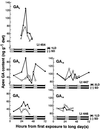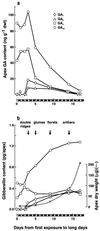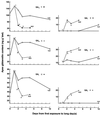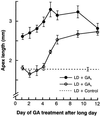Long-day induction of flowering in Lolium temulentum involves sequential increases in specific gibberellins at the shoot apex
- PMID: 11598236
- PMCID: PMC125097
Long-day induction of flowering in Lolium temulentum involves sequential increases in specific gibberellins at the shoot apex
Abstract
One challenge for plant biology has been to identify floral stimuli at the shoot apex. Using sensitive and specific gas chromatography-mass spectrometry techniques, we have followed changes in gibberellins (GAs) at the shoot apex during long day (LD)-regulated induction of flowering in the grass Lolium temulentum. Two separate roles of GAs in flowering are indicated. First, within 8 h of an inductive LD, i.e. at the time of floral evocation, the GA(5) content of the shoot apex doubled to about 120 ng g(-1) dry weight. The concentration of applied GA(5) required for floral induction of excised apices (R.W. King, C. Blundell, L.T. Evans [1993] Aust J Plant Physiol 20: 337-348) was similar to that in the shoot apex. Leaf-applied [(2)H(4)] GA(5) was transported intact from the leaf to the shoot apex, flowering being proportional to the amount of GA(5) imported. Thus, GA(5) could be part of the LD stimulus for floral evocation of L. temulentum or, alternatively, its increase at the shoot apex could follow import of a primary floral stimulus. Later, during inflorescence differentiation and especially after exposure to additional LD, a second GA action was apparent. The content of GA(1) and GA(4) in the apex increased greatly, whereas GA(5) decreased by up to 75%. GA(4) applied during inflorescence differentiation strongly promoted flowering and stem elongation, whereas it was ineffective for earlier floral evocation although it caused stem growth at all times of application. Thus, we conclude that GA(1) and GA(4) are secondary, late-acting LD stimuli for inflorescence differentiation in L. temulentum.
Figures






References
-
- Blásquez MA, Soowal LN, Lee I, Weigel D. LEAFY expression and flower initiation in Arabidopsis. Development. 1997;124:3835–3844. - PubMed
-
- Colasanti J, Sunderasan V. “Florigen” enters the molecular age: long-distance signals that cause plants to flower. Trends Biochem Sci. 2000;25:236–240. - PubMed
-
- Evans LT. The influence of environmental conditions on inflorescence development in some long day grasses. New Phytol. 1960;59:163–174.
-
- Evans LT. Inflorescence initiation in Lolium temulentum L.: V. The role of auxins and gibberellins. Aust J Biol Sci. 1964;17:10–23.
Publication types
MeSH terms
Substances
LinkOut - more resources
Full Text Sources
Research Materials
Miscellaneous
